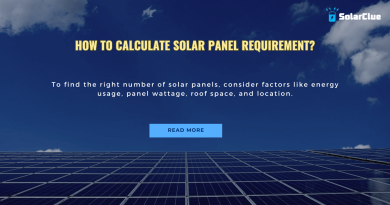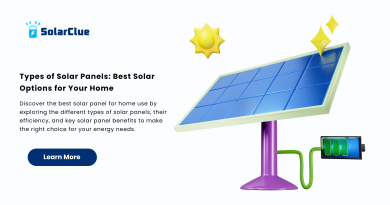How Much Do Commercial Solar Panels Cost UK
Investing in commercial solar panels can be a cost-effective way for businesses in the UK to reduce energy costs and meet sustainability goals. However, understanding the various factors that influence the cost of commercial solar installations is essential for making informed decisions. This guide covers the key elements affecting solar panel prices in the UK, available government subsidies and incentives, financing options, and current cost trends.
Table of Contents
Factors Affecting Solar Panel Prices in the UK
Panel Type:
- Monocrystalline: Offers higher efficiency but comes at a higher cost.
- Polycrystalline: More affordable but with slightly lower efficiency.
- Thin-Film: Typically the least expensive, but also the least efficient, suitable for large-scale installations.
Wattage:
- Higher Wattage Panels: Panels with higher wattage produce more electricity but are generally more expensive.
Brand:
- Premium Brands: Known for quality, durability, and performance, often commanding higher prices.
- Budget Brands: More affordable options, though they may offer lower efficiency and shorter warranties.
Installation Complexities:
- Roof Structure: Complex or non-standard roof structures can increase installation costs.
- System Size: Larger systems require more panels, labor, and materials, driving up the overall cost.
Location:
- Regional Differences: Installation costs can vary significantly across the UK due to differences in labor rates, permitting fees, and access to suppliers.
Factors Influencing Commercial Solar Panel Costs in the UK
| Factor | Impact on Cost | Explanation |
|---|---|---|
| Panel Type | Monocrystalline > Polycrystalline > Thin-Film | Higher efficiency panels typically cost more |
| Wattage | Higher wattage = Higher cost | Panels with higher wattage generate more electricity, raising the cost |
| Brand | Premium brands = Higher cost | Established brands with better warranties and performance command higher prices |
| Installation Complexity | Complex installations = Higher cost | Roof type, access issues, and system size can increase labor and material costs |
| Location | Varies by region | Costs vary depending on local labor rates, regulations, and access to suppliers |
Government Subsidies and Incentives
Feed-in Tariffs (FiT):
- Although the UK’s Feed-in Tariffs scheme closed to new applicants in 2019, businesses with existing FiT agreements continue to receive payments for electricity generated by their solar panels.
Smart Export Guarantee (SEG):
- The SEG allows businesses to earn payments for excess electricity they export back to the grid, providing a revenue stream that can offset installation costs.
Capital Allowances:
- Businesses can claim capital allowances on the cost of installing solar panels, allowing them to deduct a portion of the installation cost from their taxable profits.
Financing Options for Commercial Solar Panels
Solar Loans:
- Businesses can obtain loans specifically designed for solar installations, often with favorable interest rates and repayment terms.
Power Purchase Agreements (PPAs):
- A PPA allows a third party to install and maintain the solar system, while the business agrees to purchase the electricity generated at a lower rate than the local utility.
Leasing:
- Under a lease arrangement, a business pays a fixed monthly fee to use the solar panels, avoiding the upfront costs of installation.
Cost Trends in the UK Solar Market
Declining Costs:
- Technological Advancements: Improved manufacturing processes and technological innovations have driven down the cost of solar panels over the last decade.
- Increased Competition: As more companies enter the solar market, competition has led to more competitive pricing for commercial solar installations.
Efficiency Improvements:
- Higher Yields: Modern solar panels are more efficient, meaning businesses can generate more electricity with fewer panels, reducing overall installation costs.
Conclusion
Understanding the costs associated with commercial solar panel installations in the UK is crucial for businesses looking to invest in renewable energy. By considering factors such as panel type, wattage, installation complexity, and location, businesses can make informed decisions that maximize their return on investment. With the right financing options and a strategic approach to leveraging government incentives, solar energy can provide significant long-term savings and sustainability benefits.
This blog offers insights into the factors influencing commercial solar panel costs in the UK, helping businesses navigate the financial aspects of transitioning to solar energy and ensuring they get the best value for their investment.
Here at SolarClue®, we offer a smart, practical, and “beautiful” solution. You will be answered for all the questions related to Solar.
We provide all kinds of brands that are the Best Solar panels in India.
If you are the one who is planning for the solar power system. Don’t hesitate to contact our team!
Looking forward to empowering you with solar energy, just like hundreds of our other clients!
FAQ Section
1. What is the average cost of commercial solar panels in the UK?
The average cost of a commercial solar installation in the UK ranges from £700 to £1,000 per kW of installed capacity, depending on factors such as panel type, system size, and installation complexity.
2. Are there government incentives available for commercial solar panels in the UK?
Yes, businesses can benefit from the Smart Export Guarantee (SEG) and capital allowances on solar installations.
3. What financing options are available for commercial solar installations?
Financing options include solar loans, Power Purchase Agreements (PPAs), and leasing arrangements.
4. How does the location affect the cost of installing solar panels in the UK?
Installation costs can vary by region due to differences in labor rates, local regulations, and access to suppliers. Urban areas tend to have higher costs than rural areas.
5. What is the typical payback period for a commercial solar installation?
The payback period for a commercial solar installation in the UK typically ranges from 5 to 10 years, depending on factors such as energy savings, government incentives, and financing terms.



